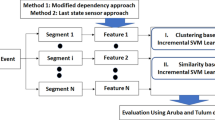Abstract
An activity recognition system on streaming data must analyze the drift in the sensing values and, at any significant change detected, decide if there is a change in the activity performed by the person. The performances of such system depend on both the feature extraction (FE) and the classification stages in the context of streaming data. In the context of streaming and high imbalanced data, this paper proposes and evaluates three FE methods in conjunction with five classification techniques. Our results on public smart home streaming data show better performances for our proposed methods comparing to the state-of-the-art baseline techniques in terms of classification accuracy, F-measure and computational time. Test on Aruba Database show an improvement in term of accuracy and computation time of the results when using the proposed method, using a KNN-based classifier (both around 87 % of correct classification but with a largely higher computing time for SVM).










Similar content being viewed by others
References
Bao L, Intille SS (2004) Activity recognition from user-annotated acceleration data. In: Pervasive computing: second international conference (PERVASIVE 2004), Linz/Vienna, Austria, April 21–23, Springer
Blanzieri E, Melgani F (2008) Nearest neighbor classification of remote sensing images with the maximal margin principle. IEEE Trans Geosci Remote Sens 46(6):1804–1811
CASAS Project (2007) Aruba, tulum datasets from wsu casas smart home project. http://ailab.wsu.edu/casas/datasets/
Chang CC, Lin CJ (2011) LIBSVM: a library for support vector machines. ACM Trans Intell Syst Technol (TIST) 2(3):Art. num. 27
Collobert R, Bengio S, Bengio Y (2002) A parallel mixture of SVMs for very large scale problems. Neural Comput 14(5):1105–1114
Cook D, Schmitter-Edgecombe M, Crandall A, Sanders C, Thomas B (2009) Collecting and disseminating smart home sensor data in the casas project. In: Proceedings of the 27th international conference on human factors in computing systems, CHI 2009, Boston, MA, USA, April 4–9
Domeniconi C, Gunopulos D (2001) Incremental support vector machine construction. In: Data mining, 2001. ICDM 2001, Proceedings IEEE international conference on, IEEE, pp 589–592
Gu T, Wu Z, Tao X, Pung HK, Lu J (2009) epSICAR: An emerging patterns based approach to sequential, interleaved and concurrent activity recognition. In: Pervasive computing and communications, 2009. PerCom 2009. IEEE international conference on, pp 1–9. doi:10.1109/PERCOM.2009.4912776
Intille SS, Larson K, Tapia EM, Beaudin JS, Kaushik P, Nawyn J, Rockinson R (2006) Using a live-in laboratory for ubiquitous computing research. In: Proceedings of the 4th international conference on pervasive computing, Springer, PERVASIVE’06, pp 349–365
Krishnan NC, Cook DJ (2014) Activity recognition on streaming sensor data. Pervasive Mob Comput 10:138–154
Li B, Chen YW, Chen YQ (2008) The nearest neighbor algorithm of local probability centers. IEEE Trans Syst Man Cybern Part B (Cybernetics) 38(1):141–154
Li Y, Zhang X (2011) Improving K nearest neighbor with exemplar generalization for imbalanced classification. In: Proceedings of the 15th Pacific-Asia conference on advances in knowledge discovery and data mining (PAKDD’11)—volume Part II, Springer, pp 321–332
Ni KS, Nguyen TQ (2009) An adaptable-nearest neighbors algorithm for mmse image interpolation. IEEE Trans Image Process 18(9):1976–1987
Poggio T, Cauwenberghs G (2001) Incremental and decremental support vector machine learning. Adv Neural Inf Process Syst 13:409
Pollack ME, Brown L, Colbry D, McCarthy CE, Orosz C, Peintner B, Ramakrishnan S, Tsamardinos I (2003) Autominder: an intelligent cognitive orthotic system for people with memory impairment. Robot Auton Syst 44(3):273–282
Pronobis A, Jie L, Caputo B (2010) The more you learn, the less you store: memory-controlled incremental svm for visual place recognition. Image Vis Comput 28(7):1080–1097
Syed NA, Huan S, Kah L, Sung K (1999) Incremental learning with support vector machines. In: Workshop on support vector machines at the international joint conference on artificial inteligence (IJCAI’99)
Tapia EM, Intille SS, Larson K (2004) Activity recognition in the home using simple and ubiquitous sensors. In: International conference on pervasive computing, Springer, pp 158–175
Voulgaris Z, Magoulas GD (2008) Extensions of the K nearest neighbour methods for classification problems. In: The 26th IASTED conference on artificial intelligence and applications, pp 23–28
Wang L, Gu T, Tao X, Lu J (2012) A hierarchical approach to real-time activity recognition in body sensor networks. Pervasive Mob Comput 8(1):115–130
Yala N, Fergani B, Fleury A (2015) Feature extraction for human activity recognition on streaming data. In: 2015 international symposium on innovations in intelligent systems and applications (INISTA’2015), Madrid, Spain, Sept. 2–4, IEEE, pp 1–6
Author information
Authors and Affiliations
Corresponding author
Rights and permissions
About this article
Cite this article
Yala, N., Fergani, B. & Fleury, A. Towards improving feature extraction and classification for activity recognition on streaming data. J Ambient Intell Human Comput 8, 177–189 (2017). https://doi.org/10.1007/s12652-016-0412-1
Received:
Accepted:
Published:
Issue Date:
DOI: https://doi.org/10.1007/s12652-016-0412-1




